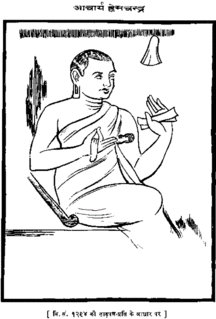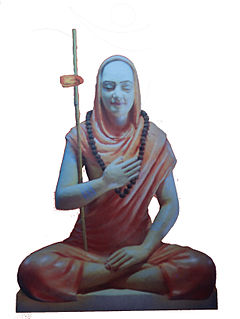| Part of a series on |
| Jain philosophy |
|---|
 |
| Concepts |
|
| People |
|
Mithyatva means "false belief", and an important concept in Jainism and Hinduism. [1] Disappearance (nivrtti) is the necessary presupposition of mithyatva because what is falsely perceived ceases to exist with the dawn of right knowledge. Mithyatva, states Jayatirtha, cannot be easily defined as 'indefinable', 'non-existent', 'something other than real', 'which cannot be proved, produced by avidya or as its effect', or as 'the nature of being perceived in the same locus along with its own absolute non-existence'. [2]

Jainism, traditionally known as Jain Dharma, is an ancient, non-theistic, Indian religion. Followers of Jainism are called "Jains", a word derived from the Sanskrit word jina (victor) and connoting the path of victory in crossing over life's stream of rebirths through an ethical and spiritual life. Jains consider their religion to be eternal (sanatan), and trace their history through a succession of 24 victorious saviours and teachers known as tirthankaras, with the first in current time cycle being Rishabhanatha, who according to Jain tradition lived millions of years ago, twenty-third being Parshvanatha in 8th century BC and twenty-fourth being the Mahāvīra around 500 BCE. Jains believe that Jainism is an eternal dharma with the tirthankaras guiding every cycle of the Jain cosmology.
Hinduism is an Indian religion and dharma, or way of life, widely practised in the Indian subcontinent and parts of Southeast Asia. Hinduism has been called the oldest religion in the world, and some practitioners and scholars refer to it as Sanātana Dharma, "the eternal tradition", or the "eternal way", beyond human history. Scholars regard Hinduism as a fusion or synthesis of various Indian cultures and traditions, with diverse roots and no founder. This "Hindu synthesis" started to develop between 500 BCE and 300 CE, after the end of the Vedic period, and flourished in the medieval period, with the decline of Buddhism in India.
Avidyā is a Sanskrit word whose literal meaning is ignorance, misconceptions, misunderstandings, incorrect knowledge, and it is the opposite of Vidya. It is used extensively in Hindu texts, including the Upanishads, and in other Indian religions such as Buddhism and Jainism, particularly in the context of metaphysical reality.
Contents
Mithyatva is a concept in Jainism distinguishing right knowledge from false knowledge, and parallels the concepts of Avidya in the Vedanta school of Hinduism, Aviveka in its Samkhya school, and Maya in Buddhism. [3]
Vedanta or Uttara Mīmāṃsā is one of the six (āstika) schools of Hindu philosophy. Vedanta literally means "end of the Vedas", reflecting ideas that emerged from the speculations and philosophies contained in the Upanishads. It does not stand for one comprehensive or unifying doctrine. Rather it is an umbrella term for many sub-traditions, ranging from dualism to non-dualism, all of which developed on the basis of a common textual connection called the Prasthanatrayi. The Prasthanatrayi is a collective term for the Principal Upanishads, the Brahma Sutras and the Bhagavad Gita.
Samkhya or Sankhya is one of the six āstika schools of Hindu philosophy. It is most related to the Yoga school of Hinduism, and it was influential on other schools of Indian philosophy. Sāmkhya is an enumerationist philosophy whose epistemology accepts three of six pramanas (proofs) as the only reliable means of gaining knowledge. These include pratyakṣa (perception), anumāṇa (inference) and śabda. Sometimes described as one of the rationalist schools of Indian philosophy, this ancient school's reliance on reason was exclusive but strong.

Buddhism is the world's fourth-largest religion with over 520 million followers, or over 7% of the global population, known as Buddhists. Buddhism encompasses a variety of traditions, beliefs and spiritual practices largely based on original teachings attributed to the Buddha and resulting interpreted philosophies. Buddhism originated in ancient India as a Sramana tradition sometime between the 6th and 4th centuries BCE, spreading through much of Asia. Two major extant branches of Buddhism are generally recognized by scholars: Theravada and Mahayana.
The opposite of Mithyatva (false belief) is Samyaktva (right belief). [4]







